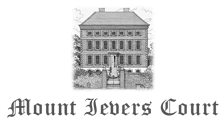George Ievers (c. 1757-1808) of Mount Ievers
George was the fourth son of Robert and Mary Ievers of Castle Ievers. He narrowly avoided death as a child when a small pox epidemic swept through the family home, killing his sister Mary. His mother Mary, one of the Parsons of Cragbeg, Co. Limerick, died in 1772 when he was about fifteen years old. The following year, his father Robert was married secondly to Jane Butler with whom he had a further three sons and three daughters, making a fine total of 13 children.
On 6th March 1783, George was married to Elinor (Eleanor) Butler, sister of James Butler of Castlecrine, Co. Limerick (see below), and of Eyre Edward Butler, a prosperous cotton planter in British Guiana. His own sister Mary had married another of these Butlers the previous year. George’s father died nine months after their marriage, and George appears to have succeeded to Mount Ievers then.
George and Elinor had six sons and four daughters as follows:
1. Robert went to Westminster School in London on 23 Feb 1795. Married 1813 Isabella Henrietta Fitzgerald, d. Nov 1825, leaving issue George (d. Dec 1828) and Ellen (1815-1827) and Agnes Geraldine Ievers (who died unmarried).
2. William Ievers was married on 24th February 1831 to Anne, daughter of Lucius Wilson of Ryanagh and Springfield, Co. Clare, and died without issue on 17th Oct 1849. Anne’s sister Eliza was married to William’s cousin David Wilson Ievers.
3. George Ievers, dunm 7 Dec 1828.

Above: Thomas Ievers (1792-1832)
4. Thomas Ievers was born in 1792 and promoted from Ensign to Lieutenant in the 8th (King's) Regiment of Foot on 4th April 1809.[i] It seems likely this refers to a promotion following the death of a huge number of men from the regiment while based upon the disease-riddled island of Martinqiue. He later lived at Abbeyview, Crusheen, County Clare, and died unmarried on 12th December 1832. His portrait hangs at Mount Ievers.
5. James Ievers, JP, of Glenfield, was married at Bruff Church in 1828 to his cousin Eliza or Elizabeth, third daughter of Richard Ievers of Green Park, Kilmallock, and died without issue.[ii] He leased nearly 8 acres of land from James Cree, husband of his sister Jane.
6. Eyre Butler Ievers, of the Mount Ievers line, to whom we will return presently.
7. Elizabeth, or Eliza, was born in 1789, the year the French revolution began. She lived in Limerick where she died unmarried at Thomond Place, on 24th October 1863.[iii]
8. Mary was married in 1834 to Capt. Richard Waller Shinkwin, 10th Regt, of Deebert, Kilmallock, Co. Limerick. She died in March 1843, leaving two sons. Captain Shinkwin did not long survive her, dying of fever at Deebert in October 1848. His death notice stated that he had served in the 10th for many years; his monument in Kilmallock states ’28 years’. ‘Deeply regretted by his brother officers, relatives and numerous friends’, he was to be buried in the family vault in Kilmallock.[iv] On 22nd November 1852, their son James Richard Shinkwin, a ‘mercl clerk’ [sic], was married at St. Mary’s, Dublin, to Mary Blanchfield, dressmaker, of 10 Abbey Street, Dublin. Her father was Samuel Blanchfield.[v]
9. Jane Ievers was married in July 1828 to James Cree (1787-1853) of Thomond Place, Limerick. He was a member of the Cree family, Glaswegian merchants, and settled in Limerick in the 1820s. On 6th January 1858, Jane Cree was granted a fee-farm in respect of three houses and gardens in Cashel's Lane, Limerick. She died ‘at her residence’, Sweetmount House, Dundrum, on 19th June 1872, leaving two sons, George and John, and one daughter, Sophia. Jane Cree was buried alongside her husband in St. Munchin’s churchyard.[vi]
10. Ellen, baptised 23 Jan 1797, bur. Kilfinaghty 1 Nov 1805.
George’s older brothers Henry and Thomas died in 1802 and 1803 respectively. His wife Elinor died on 1 November 1805, ten days after Nelson’s victory over the French at Trafalgar. Given that their seven-year-old youngest daughter Ellen died the same day, perhaps there was a fever or tragic accident.
Less than three years later, George Ievers died of a heart attack (‘apoplexy’) when, on 22nd March 1808, he stood as a second in a fatal duel which took place in a little churchyard between Sixmilebridge and Ballintlea. Mr. McNamara shot and killed William Hammond, ‘a gentleman of respectability and fortune in County Clare’. George Ievers’ subsequent heart attack may have stemmed from some form of shame or anxiety about his having stood as second while he was supposed to have been a law-abiding magistrate. That said, the solitary reference I have found to this duel so far is on page 58 of ‘Irish houses & castles’ (Viking Press, 2 Nov 1971) by Desmond Guinness and William Ryan.
Hammond was already infamous across County Clare for having fatally wounded William Foley of Shepperton at another dual in Sixmilebridge which took place two months earlier, on 23rd January 1808.[vii] The duel had been conducted in an honourable manner. Hammond was shot in the wrist but Foley was mortally wounded when the ball passed through his intestines and perforated his spine. He died later that evening in great agony. The jury at the County Clare assizes gave Hammond a unanimous verdict of ‘guilty of manslaughter in his own defence’. That should have been his ticket to freedom. However, Judge Edward Mayne of the Court of Common Pleas took a hard-line response and ordered the jury to either remove the ‘in his own defence’ get-out clause or bump up the charge to homicide. The jury refused but Judge Mayne nonetheless sentenced Hammond to 12 months imprisonment, and to be burned on the hand. Hammond’s appeal to the Court of King’s Bench fell on deaf ears. He did secure an early release but died shortly afterwards in the duel with McNamara.
